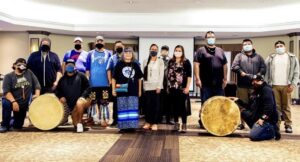Hearts and minds come together for 43rd annual pow wow in Chippewas of the Thames First Nation

By Colin Graf
DESHKAN ZIIBIING (CHIPPEWAS OF THE THAMES FIRST NATION)— Pow wow organizers in Chippewas of the Thames First Nation (COTTFN) have successfully held their 43rd annual powwow in a new and almost untested way.
Instead of the pre-recorded internet broadcast that many First Nations have adopted in 2020 in light of the coronavirus disease 2019 (COVID-19) pandemic, COTTFN Communications Coordinator Ashley Albert shares that the community decided instead to have the music and dancers perform live, with an MC also doing live introductions.
With the participation of two drum groups and dancers from across Turtle Island, the event garnered around 6,000 views online, creating “a complete success,” says powwow MC Gordon Sands of London.
Albert echoes Sands’ opinion.
“At the end of the day, it went really well. Our vision was to bring together the community members, audience, others who like to watch powwows, drummers and dancers, and I think we successfully did that,” she tells Anishinabek News.
She credits Sands and Head Judge Lisa Hill with pushing the idea of a live powwow.
“They said, ‘We don’t want videos, we want to see them live, we want the feel of a live powwow,’” she explains.
The Grand Entry and speeches from officials were pre-recorded at the COTTFN powwow grounds, while the rest took place in real-time on Oct. 16-18, with two drum and singing groups, a technical crew, and MC Sands well-spaced out in a hotel conference room near the community. Organizers explain that each dancer arranged to have an internet device and a video operator so they could hear the music, perform to it, and broadcast it by Zoom at the same time as the music was being performed.
While real-time, live performances provide an element of surprise and excitement, pow wow organizers across Turtle Island are adapting to the new normal and bringing the spirit of pow wows to viewers at home.
While Sands won’t say the powwow was as good as the real thing, he thinks it was “a pretty close second.”
Introducing the powwow, COTTFN Chief Jacqueline French thanked the staff and powwow committee for arranging the event and offered her hope “that by joining us, it will bring some joy and happiness and healing and whatever it is you may need at this time,” for her community members and other viewers.
Figuring out how to stage the powwow, with both technical complications and the need to follow pandemic protocols, was a challenge, says Albert, but she credits the hard work of the committee of about seven members with pulling it off, preventing any break in the long history of the event.
“You can’t go wrong when your hearts and minds are together,” says Sands, paying tribute to the crew who handled the broadcast.
Only one thing seemed missing, according to Albert.
“I got a lot of comments saying, ‘All we need now is powwow food,’” she relates.
The crew had some technical problems with Zoom shutting off the sound of the drums and singers occasionally on the heaviest drumbeats one day, says Albert, but a way was found to adjust the volume on the recording device to solve the problem.
“Nobody complained too much,” she says. “We didn’t realize Zoom is very picky when it comes to loud sounds.”
Organizers received a lot of positive feedback during and following the virtual event.
“A lot of members were saying, ‘Yeah I feel like I got to come home for the powwow,’” the communications coordinator and powwow videographer relates.
While things went off pretty well technically, the committee has decided if they have to do it virtually next year, “the number one thing is to hire a professional media company,” Albert says. Even if a normal in-person powwow can be held then, she hopes to have a live broadcast for community members who cannot make it to the powwow grounds.
The feeling in the conference room during the event was powerful, Sands recalls. There was a limit of 12 people in the conference room due to public health rules.
“Everyone who wasn’t singing had their eyes glued to their screens, and they couldn’t believe people were dancing in their backyards or their living rooms [as the music rang out],” he remembers.
The musical guests, host drum Eagle Flight from London, and Young Creek from Toronto were able to perform while respecting COVID-19 restrictions. The groups were at opposite ends of the room, and each was a family group who had contact with each other prior to the powwow.
“We played it pretty safe,” says Sands. “Temperatures were taken, and a few of us took the (COVID) test a few days prior.”
The dancers included 12 Tiny Tots and 35 competing in the youth, teen, adult, and Golden Age categories, says Albert. Men and boys competed in Traditional, Grass, and Fancy Grass Styles, while women and girls took part in Traditional, Fancy, and Jingle Styles, Albert explains.
The numbers were short of the usual 100 – 150 competitors usually participating in a COTTFN powwow, says Sands, but adds that “the spirit was definitely there.” According to Sands, dancers performed from as far away as California, Toronto, and from the Midwest and Western states.
Sands says he is only aware of one other live online powwow in COVID-19 times, one that he also acted as MC for, staged by the Association of Iroquois and Allied Indians earlier in 2020. That event was not a competition, but he notes that an honorarium was provided to invited dancers who performed for the Association’s annual “Elders Gathering.”


